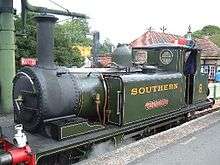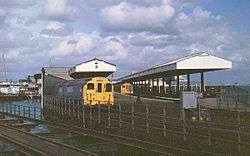Railways on the Isle of Wight

There once existed a 55 1⁄2-mile (89.3 km) network of railway lines on the Isle of Wight. They were opened by several companies between 1862 and 1901, and all but the 8 1⁄2-mile-long (13.7 km) Island Line closed between 1952 and 1966.[1] A further 5 1⁄2 miles (8.9 km) have reopened as the Isle of Wight Steam Railway.[2]
Early beginnings
The first railway to be built on the island ran for a distance of 2,500 yards (2,300 m). It was opened in 1833 on the Nash Estate near Yarmouth. Its usage is presumed to have been for transporting brickmaking materials to and from a jetty on the Solent, and it is not thought to have used mechanical traction.[3] The line is now abandoned.
The independent companies
The first conventional railway line to open on the island was that from Cowes to Newport. The Cowes & Newport Railway Company began construction of the line in 1859 after an enabling Act of Parliament was passed earlier that year. The line opened to passengers in June 1862.[4]
Shortly after this, the Isle of Wight Railway (IWR) company built its initial line from Ryde to Shanklin, opening in 1864. Also in 1864, horse-drawn trams began running along Ryde Pier, connecting ferry services to the town. The IWR opened an extension of its main line to reach Ventnor in 1866. In 1871, the Ryde tramway was extended to meet the railway line at Ryde St John's Road.[5]
The Ryde & Newport Railway opened in December 1875, with operations controlled by the Cowes & Newport company.[4]
In 1875, the Isle of Wight (Newport Junction) Railway opened the main part of its 10-mile Sandown to Newport line, planned in 1868. It would have opened sooner, but failed official inspections. In February 1875, the line was opened between Shide, a suburb of Newport, and the IWR station at Sandown. Eight months later the line was extended a further half mile to reach Pan Lane. However, the final half-mile from there to Newport station did not open until 1879. Four years of poor connections in Newport meant not enough passengers or freight had been attracted to the line, and the company passed into receivership in 1880. At this point, it was bought by the Cowes & Newport/Ryde & Newport company, who were legally renamed as the Isle of Wight Central Railway.[4]
In 1877 the London, Brighton and South Coast Railway and London and South Western Railway were granted an Act of Parliament to extend Ryde Pier, building a railway line from the pier head to St John's Road. This was completed in 1880, and at this point the Ryde tramway was shortened to simply run along the pier.[1]
In 1882, the IWR opened a branch line from Brading to Bembridge, serving a large natural harbour between Bembridge and St Helen's stations. A short-lived train ferry from Bembridge Harbour to the Hayling Island branch also started at this point.[4]

In 1889, the Freshwater, Yarmouth and Newport Railway(FYN) opened its 12-mile line from Newport to Freshwater, the only line to run west of Newport. Services on its line were operated by the IWCR under a mutual agreement.
The network was completed by the Newport, Godshill and St Lawrence Railway's Ventnor West branch line from Merstone, on the Sandown-Newport line, to St Lawrence on the south coast. This was opened in 1897, and extended to Ventnor West in June 1900. This line, the last to be built on the island, was taken over by the Isle of Wight Central.[4]
By the end of 1900, a total of 55½ miles of railway covered the island, including railway lines on Ryde Pier (but excluding the pier tramway).[6]
A fixed railway link to the mainland was authorised by Parliament in 1903. The South West and Isle of Wight Junction Railway was a joint project between the London & South Western Railway and the FYN. The excavation of a two and a half-mile long tunnel was approved in 1903, 1904 and 1909. However, the tunnel project was abandoned due the outbreak of the First World War in 1914.[4][7]
As mentioned above, the IWCR and FYN had an agreement whereby the IWCR would provide the train service along the FYN line. However, in 1913 this agreement deteriorated to the point that the FYN was forced to purchase its own locomotives and rolling stock.
Southern Railway

After the Railways Act 1921 came into force from January 1923, the Southern Railway took over all lines on the island, although the integration of the FYN took some time due to financial wrangling. The company set about significant investment in the island's rail services, primarily through replacing old locomotives and carriages. Twenty-three O2 Class locomotives were transferred to the island from the former London and South Western Railway's suburban services,[8] and many coaches were brought from the former London, Chatham and Dover Railway and London, Brighton and South Coast Railway.[9] The locomotives were given numbers under an unusual system where each number was individual only on the island. Each locomotive officially carried its number with a W-prefix to indicate this, and was given a nameplate relating to somewhere on the island (e.g. W 24—Calbourne).[8]
The Southern also carried out changes in track layout to make services more flexible, such as the installation of double track from Brading to Sandown, new passing loops at Havenstreet and Wroxall stations, and pointwork at Smallbrook Junction.[1] A new named train called The Tourist was set up, running from Ventnor to Freshwater via Sandown, Merstone and Newport. It was the only named train on the island, and travelled on lines from all the former Isle of Wight railway companies.
Nationalisation, privatisation and preservation

In 1948, the railways of the United Kingdom, including those on the island, were nationalised as British Railways.[4] Under separate modernisation schemes, the FYN line, Ventnor West line, Bembridge branch and Sandown to Newport line had closed by the end of 1956. In 1966, under the recommendations of the Beeching Report, services were withdrawn on the Ryde to Newport and Cowes lines, and between Shanklin and Ventnor.
The line between Ryde and Shanklin was also earmarked for closure by Beeching, but the TUCC stated that this would cause severe hardship and the Minister of Transport refused consent, so management decided to authorise electrification instead. This remaining Ryde-Shanklin line was electrified using the third rail system and Class 485 and Class 486 trains, which had previously worked on the London Underground. The new electric service began in March 1967.[10]
In 1971, the Isle of Wight Steam Railway began operating on part of the Ryde to Newport line. Their operation extended to reach 5½ miles[2] in 1991, and they are now focused on restoring their substantial fleet of historic carriages.[11]
In 1990, the newer fleet of Class 483 trains replaced the older electric units on the Ryde-Shanklin line. The line and passenger services were branded as Island Line (replacing the former RydeRail brand), and in 1996 the passenger service was privatised as the Island Line franchise,[12] which was absorbed into the South Western franchise in 2007. Since then, electric services on the line have continued to run under the name Island Line Trains.
Fate of the abandoned lines
Many of the railway lines abandoned between 1952[1] and 1966 have found other uses. The tunnel between St Lawrence and Whitwell was until recently home to a mushroom farm, while the one from Ventnor to Wroxall is now used to collect and transport Ventnor's water supply. From 2004 Ventnor and St Lawrence were served by the Ventnor Rail Link bus from Shanklin, although this was withdrawn in 2010. Newport railway station was completely demolished in 1971 to make way for an upgrade of the A3054 road. Most of the network has been turned into "rail trail" cyclepaths, and notably the island's section of National Cycle Route 23 was constructed mainly on the former Sandown-Newport-Cowes line of the Isle of Wight Central Railway.[13] However, much of the former Merstone–Ventnor West and FYN lines have no public access, the main exception being the route between Yarmouth and Freshwater.
The future
In August 2017, the franchise was taken over by South Western Railway who have maintained the brand name.
There are numerous plans for the island's rail system, including:
- the extension of steam services from Smallbrook Junction to Ryde St John's Road station
- conversion of the Island Line to a tramway and extending into Shanklin town centre
- extension of steam railway to reach Newport
- extension of Island Line into Ventnor along the old route (first considered in 1967)[14]
- extension of the Island Line to Gosport, Hampshire via a new Solent tunnel[15]
Footnotes
- 1 2 3 4 Hardy (2003) p. 9
- 1 2 "Gradient Profile". Isle of Wight Steam Railway. Archived from the original on 20 September 2007. Retrieved 24 March 2009.
- ↑ Allen & MacLeod (1986) p. 92
- 1 2 3 4 5 6 7 "The Isle of Wight Steam Railway". Isle of Wight Beacon. Retrieved 22 March 2009.
- ↑ Hardy (2003) pp.6-7
- ↑ Hardy (2003) p.6
- ↑ "Lymington-Keyhaven, West Solent - part of Geology of the Wessex Coast". Southampton University. Retrieved 26 March 2009.
- 1 2 "Calbourne". Isle of Wight Steam Railway. Retrieved 24 March 2009.
- ↑ "stock list". Isle of Wight Steam Railway. Retrieved 24 March 2009.
- ↑ Hardy (2003) pp. 19-20
- ↑ "Rolling stock shed appeal". Isle of Wight Steam Railway. December 2008. Retrieved 24 March 2009.
- ↑ Hardy (2003) p. 75
- ↑ "Sustrans Hampshire and the Isle of Wight". Sustrans. Retrieved 24 March 2009.
- ↑ Hardy (2003) p.20
- ↑ "Tram Link Idea Wins Poll Approval". Isle of Wight County Press. 11 April 2008. Archived from the original on 23 October 2017. Retrieved 13 May 2017.
Sources
Bibliography
- Burroughs, R.E. (1968). The Great Isle of Wight Train Robbery. London: The Railway Invigoration Society. p. 47.
Further reading
- Allen, P.C. (2014). Railways of the Isle of Wight. Amberley Publishing. ISBN 9781445637846. OCLC 871305887.
- Allen, P C; MacLeod, A B (1986). Rails in the Isle of Wight, second edition. David & Charles, Newton Abbot,. ISBN 0 7153 87014.
- Golden, Laurie (2011). Vectis Steam: The Last Years of Steam on the Isle of Wight. Ian Allan. ISBN 9780711036420. OCLC 881513055.
- Hay, Peter (1988). Steaming Through the Isle of Wight. Middleton Press. ISBN 9780906520567. OCLC 24725322.
- Jacobs, Mike (2015). Memories of Isle of Wight Railways. Noodle Books. ISBN 9781906419363. OCLC 502424669.
- Kardas, Handel (1998). Portrait of the Isle of Wight Railways. Ian Allan. ISBN 9780711025745. OCLC 43197506.
- Long, Richard (2015). Isle of Wight Railways: A New History. Ian Allan. ISBN 9780711038165. OCLC 913052158.
- Maycock, R.J.; Silsbury, R. (2001). The Isle of Wight Central Railway. The Oakwood Press. ISBN 9780853615736. OCLC 59361866.
- Mitchell, Vic; Smith, Keith (1985). Branch Lines to Newport. Middleton Press. ISBN 9780906520260. OCLC 60024112.
- Mitchell, Vic; Smith, Keith (1998). Isle of Wight Lines: 50 Years of Change. Middleton Press. ISBN 9781901706123. OCLC 41158994.
- Mitchell, Vic; Smith, Keith (1985). South Coast Railways: Ryde to Ventnor. Middleton Press. ISBN 9780906520192. OCLC 13860206.
- Panter, Marie (2013). Railways of the Isle of Wight. Stenlake Publishing. ISBN 9781840335927. OCLC 854907927.
- Paye, Peter. Isle of Wight Railways Remembered. OPC. ISBN 9780860932123. OCLC 17676065.
- Pomeroy, Colin (1991). Isle of Wight Railways. Silver Link Publishing Ltd. ISBN 9780947971625. OCLC 27147645.
- Robbins, Michael (1953). The Isle of Wight Railways. Oakwood Press. OCLC 12241170.
- Whittington, C.J. (1972). Railways in the Wight. Shanklin: G.G. Saunders and Co. Ltd. ISBN 9780950338705. OCLC 16235962.
External links